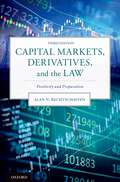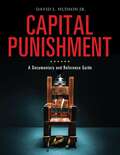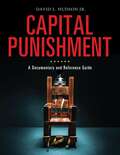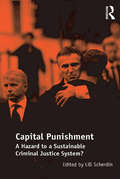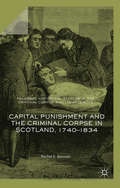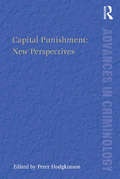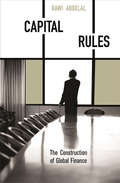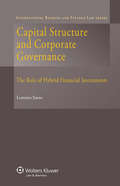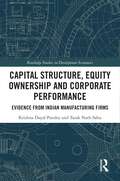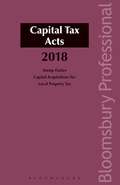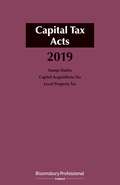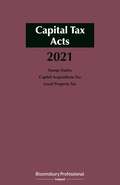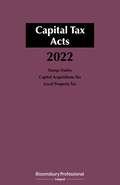- Table View
- List View
Capital Markets, Derivatives, and the Law: Positivity and Preparation
by Alan N. RechtschaffenDramatic failures in individual markets and institutions sparked a global financial crisis that resulted in political, social, and economic unrest. In the United States, a host of legislative acts have completely reshaped the regulatory landscape. Capital Markets, Derivatives and the Law: Positivity and Preparation investigates the impact of the financial crisis on capital markets and regulation. With an emphasis on the structure and the workings of financial instruments, it considers market evolution after the crisis and the impact of Central Bank policy. In doing so, it provides the reader with the tools to recognize vulnerabilities in capital market trading activities. This edition serves as an essential guide to better understand the legal and business considerations of capital market participation. With useful definitions, case law examples, and expert insight into structures, regulation, and litigation strategies, Capital Markets, Derivatives and the Law: Positivity and Preparation offers readers invaluable tools to make prudent, well-informed decisions.
Capital Markets, Derivatives, and the Law: Positivity and Preparation
by Alan N. RechtschaffenDramatic failures in individual markets and institutions sparked a global financial crisis that resulted in political, social, and economic unrest. In the United States, a host of legislative acts have completely reshaped the regulatory landscape. Capital Markets, Derivatives and the Law: Positivity and Preparation investigates the impact of the financial crisis on capital markets and regulation. With an emphasis on the structure and the workings of financial instruments, it considers market evolution after the crisis and the impact of Central Bank policy. In doing so, it provides the reader with the tools to recognize vulnerabilities in capital market trading activities. This edition serves as an essential guide to better understand the legal and business considerations of capital market participation. With useful definitions, case law examples, and expert insight into structures, regulation, and litigation strategies, Capital Markets, Derivatives and the Law: Positivity and Preparation offers readers invaluable tools to make prudent, well-informed decisions.
Capital Markets Union in Europe (Oxford EU Financial Regulation)
by Danny Busch, Emilios Avgouleas and Guido FerrariniCapital Markets Union in Europe analyses the legal and economic implications of the European Commission's plans to form a Capital Markets Union (CMU) in Europe, which will have a major impact on financial markets and institutions both in the region and beyond. A detailed introductory chapter provides a broad overview of the various aspects and challenges of the CMU proposals, whilst thematically grouped chapters cover the following areas: (i) general aspects, (ii) Brexit, (iii) financing innovation, (iv) raising capital on the capital markets, (v) fostering retail and institutional investment, (vi) leveraging banking capacity to support the wider economy, (vii) facilitating cross-border investing, and (viii) comparative aspects of capital market integration. Written by world renowned experts in the fields of banking and capital markets, including respected academics, with broad practical experience, and leading practitioners, Capital Markets Union in Europe provides high-quality analysis of the legal and economic issues in a practical context.
Capital Markets Union in Europe (Oxford EU Financial Regulation)
Capital Markets Union in Europe analyses the legal and economic implications of the European Commission's plans to form a Capital Markets Union (CMU) in Europe, which will have a major impact on financial markets and institutions both in the region and beyond. A detailed introductory chapter provides a broad overview of the various aspects and challenges of the CMU proposals, whilst thematically grouped chapters cover the following areas: (i) general aspects, (ii) Brexit, (iii) financing innovation, (iv) raising capital on the capital markets, (v) fostering retail and institutional investment, (vi) leveraging banking capacity to support the wider economy, (vii) facilitating cross-border investing, and (viii) comparative aspects of capital market integration. Written by world renowned experts in the fields of banking and capital markets, including respected academics, with broad practical experience, and leading practitioners, Capital Markets Union in Europe provides high-quality analysis of the legal and economic issues in a practical context.
Capital Punishment: A Documentary and Reference Guide (Documentary and Reference Guides)
by David L. Jr.Each entry in this essential collection of primary resources on capital punishment features an authoritative introduction and analysis that helps provide crucial context for understanding the evolution of law and public attitudes toward the death penalty in America, from colonial times to the present.Showcasing key primary documents that illuminate the ongoing debate and turbulent history of capital punishment in the United States, this collection gathers a wide range of fascinating and momentous documents, including court decisions and transcripts, legislation, personal accounts and perspectives, congressional testimony, and government documents. Since these documents reflect all political perspectives and messaging, students will gain valuable insight into the evolution of public opinion and government policy on the death penalty in America. To better understand these documents, each primary source is prefaced with an introduction and followed by scholarly analysis. These documents and accompanying analysis complement one another, helping students gain a better and more accurate understanding of the viewpoints, convictions, and perspectives that have shaped American attitudes and practices toward capital punishment since the United States' earliest days.
Capital Punishment: A Documentary and Reference Guide (Documentary and Reference Guides)
by David L. Jr.Each entry in this essential collection of primary resources on capital punishment features an authoritative introduction and analysis that helps provide crucial context for understanding the evolution of law and public attitudes toward the death penalty in America, from colonial times to the present.Showcasing key primary documents that illuminate the ongoing debate and turbulent history of capital punishment in the United States, this collection gathers a wide range of fascinating and momentous documents, including court decisions and transcripts, legislation, personal accounts and perspectives, congressional testimony, and government documents. Since these documents reflect all political perspectives and messaging, students will gain valuable insight into the evolution of public opinion and government policy on the death penalty in America. To better understand these documents, each primary source is prefaced with an introduction and followed by scholarly analysis. These documents and accompanying analysis complement one another, helping students gain a better and more accurate understanding of the viewpoints, convictions, and perspectives that have shaped American attitudes and practices toward capital punishment since the United States' earliest days.
Capital Punishment: A Reference Handbook (Contemporary World Issues)
by Michael KronenwetterThis revised edition of a perennial bestseller, with more than 50 percent new material, is a much-needed overview of a hotly debated topic.Capital Punishment focuses on the use of the death penalty in the United States, its international status, and how foreign developments affect the country. It includes a history, a discussion of the controversies surrounding the death penalty, updated biographical sketches, and statistics. Key documents include the U.S. Supreme Court decision affirming capital punishment, a key dissent, Charles Dickens' 19th century view of the guillotine, and various papal and European Union decrees. It also includes a chronology, organizations, websites with further information, and an annotated bibliography.In this updated survey, a thorough overview of capital punishment, author Michael Kronenwetter reveals interesting facts, for example, under Roman law, death was the penalty for publishing "insulting songs" and disturbing the city's peace.
Capital Punishment: An Encyclopedia of History, Politics, Culture, and the Law
by Joseph A. MeluskyThis authoritative, balanced, and accessible reference resource provides readers with a wide-ranging survey of capital punishment in America, including its history, its legal and cultural foundations, and racial and economic factors in its application.This carefully crafted primer on the history and present state of capital punishment in the United States examines cultural, political, and legal factors and developments, as well as key figures, groups, and movements, by consolidating a wide variety of material into a single, convenient source.Utilizing a rich and varied array of scholarship and primary sources, this work examines historical, political, cultural, and legal factors and developments that have shaped the contours of capital punishment throughout American history. It examines key figures and organizations who have played pivotal roles in debates over the death penalty; provides readers with illuminating coverage of laws, cases, and the people involved; discusses the experiences of death row inmates; and explores questions and controversies revolving around the socioeconomic factors that influence the use of capital punishment.
Capital Punishment (Historical Guides to Controversial Issues in America)
by Joseph A. Melusky Keith A. PestoThis balanced approach to legal precedent and moral argument regarding the death penalty presents the evidence so readers can reach their own informed conclusions.Capital Punishment examines the debate around the death penalty, raising questions and attempting to provide an even-handed examination of this controversial practice. The authors combine analysis of important issues with excerpts from landmark legal decisions, important documents, survey results, and empirical data. The first part of the book discusses the origins of the death penalty and traces its development from antiquity to contemporary times. Detailed statistical information about capital punishment is presented and discussed, and the death penalty is considered against a constitutional backdrop with various arguments—for and against—articulated. The second part of the book consists of three appendices. The first appendix presents an annotated list of important capital-punishment cases; the second supplies a more general chronological treatment of capital punishment; and the third provides a bibliographic essay directing readers to other relevant sources of interest. A thorough and insightful treatment, Capital Punishment provides both a summary of the current state of capital punishment and a discussion of areas of continuing controversy.
Capital Punishment: A Hazard to a Sustainable Criminal Justice System?
by Lill ScherdinAs most jurisdictions move away from the death penalty, some remain strongly committed to it, while others hold on to it but use it sparingly. This volume seeks to understand why, by examining the death penalty’s relationship to state governance in the past and present. It also examines how international, transnational and national forces intersect in order to understand the possibilities of future death penalty abolition. The chapters cover the USA - the only western democracy that still uses the death penalty - and Asia - the site of some 90 per cent of all executions. Also included are discussions of the death penalty in Islam and its practice in selected Muslim majority countries. There is also a comparative chapter departing from the response to the mass killings in Norway in 2011. Leading experts in law, criminology and human rights combine theory and empirical research to further our understanding of the relationships between ways of governance, the role of leadership and the death penalty practices. This book questions whether the death penalty in and of itself is a hazard to a sustainable development of criminal justice. It is an invaluable resource for all those researching and campaigning for the global abolition of capital punishment.
Capital Punishment: A Hazard to a Sustainable Criminal Justice System?
by Lill ScherdinAs most jurisdictions move away from the death penalty, some remain strongly committed to it, while others hold on to it but use it sparingly. This volume seeks to understand why, by examining the death penalty’s relationship to state governance in the past and present. It also examines how international, transnational and national forces intersect in order to understand the possibilities of future death penalty abolition. The chapters cover the USA - the only western democracy that still uses the death penalty - and Asia - the site of some 90 per cent of all executions. Also included are discussions of the death penalty in Islam and its practice in selected Muslim majority countries. There is also a comparative chapter departing from the response to the mass killings in Norway in 2011. Leading experts in law, criminology and human rights combine theory and empirical research to further our understanding of the relationships between ways of governance, the role of leadership and the death penalty practices. This book questions whether the death penalty in and of itself is a hazard to a sustainable development of criminal justice. It is an invaluable resource for all those researching and campaigning for the global abolition of capital punishment.
Capital Punishment: An Encyclopedia of History, Politics, Culture, and the Law
This authoritative, balanced, and accessible reference resource provides readers with a wide-ranging survey of capital punishment in America, including its history, its legal and cultural foundations, and racial and economic factors in its application.This carefully crafted primer on the history and present state of capital punishment in the United States examines cultural, political, and legal factors and developments, as well as key figures, groups, and movements, by consolidating a wide variety of material into a single, convenient source.Utilizing a rich and varied array of scholarship and primary sources, this work examines historical, political, cultural, and legal factors and developments that have shaped the contours of capital punishment throughout American history. It examines key figures and organizations who have played pivotal roles in debates over the death penalty; provides readers with illuminating coverage of laws, cases, and the people involved; discusses the experiences of death row inmates; and explores questions and controversies revolving around the socioeconomic factors that influence the use of capital punishment.
Capital Punishment and the Criminal Corpse in Scotland, 1740–1834
by Rachel E. BennettThis book is open access under a CC BY 4. 0 license. This book provides the most in-depth study of capital punishment in Scotland between the mid-eighteenth and early nineteenth century to date. Based upon an extensive gathering and analysis of previously untapped resources, it takes the reader on a journey from the courtrooms of Scotland to the theatre of the gallows. It introduces them to several of the malefactors who faced the hangman's noose and explores the traditional hallmarks of the spectacle of the scaffold. It demonstrates that the period between 1740 and 1834 was one of discussion, debate and fundamental change in the use of the death sentence and how it was staged in practice. In addition, the study provides an innovative investigation of the post-mortem punishment of the criminal corpse. It offers the reader an insight into the scene at the foot of the gibbets from which criminal bodies were displayed and around the dissection tables of Scotland's main universities where criminal bodies were used as cadavers for anatomical demonstration. In doing so it reveals an intermediate stage in the long-term disappearance of public bodily punishment.
Capital Punishment: New Perspectives (New Advances in Crime and Social Harm)
by Peter HodgkinsonThis collection asks questions about the received wisdom of the debate about capital punishment. Woven through the book, questions are asked of, and remedies proposed for, a raft of issues identified as having been overlooked in the traditional discourse. It provides a long overdue review of the disparate groups and strategies that lay claim to abolitionism. The authors argue that capital litigators should use their skills challenging the abuses not just of process, but of the conditions in which the condemned await their fate, namely prison conditions, education, leisure, visits, medical services, etc. In the aftermath of successful constitutional challenges it is the beneficiaries (arguably those who are considered successes, having been ’saved’ from the death penalty and now serving living death penalties of one sort or another) who are suffering the cruel and inhumane alternative. Part I of the book offers a selection of diverse, nuanced examinations of death penalty phenomena, scrutinizing complexities frequently omitted from the narrative of academics and activists. It offers a challenging and comprehensive analysis of issues critical to the abolition debate. Part II offers examinations of countries usually absent from academic analysis to provide an understanding of the status of the debate locally, with opportunities for wider application.
Capital Punishment: New Perspectives (New Advances in Crime and Social Harm)
by Peter HodgkinsonThis collection asks questions about the received wisdom of the debate about capital punishment. Woven through the book, questions are asked of, and remedies proposed for, a raft of issues identified as having been overlooked in the traditional discourse. It provides a long overdue review of the disparate groups and strategies that lay claim to abolitionism. The authors argue that capital litigators should use their skills challenging the abuses not just of process, but of the conditions in which the condemned await their fate, namely prison conditions, education, leisure, visits, medical services, etc. In the aftermath of successful constitutional challenges it is the beneficiaries (arguably those who are considered successes, having been ’saved’ from the death penalty and now serving living death penalties of one sort or another) who are suffering the cruel and inhumane alternative. Part I of the book offers a selection of diverse, nuanced examinations of death penalty phenomena, scrutinizing complexities frequently omitted from the narrative of academics and activists. It offers a challenging and comprehensive analysis of issues critical to the abolition debate. Part II offers examinations of countries usually absent from academic analysis to provide an understanding of the status of the debate locally, with opportunities for wider application.
Capital Rules: The Construction of Global Finance
by Rawi Abdelal"The rise of global financial markets in the last decades of the twentieth century was premised on one fundamental idea: that capital ought to flow across country borders with minimal restriction and regulation. Freedom for capital movements became the new orthodoxy. In an intellectual, legal, and political history of financial globalization, Rawi Abdelal shows that this was not always the case. Transactions routinely executed by bankers, managers, and investors during the 1990s—trading foreign stocks and bonds, borrowing in foreign currencies—had been illegal in many countries only decades, and sometimes just a year or two, earlier. How and why did the world shift from an orthodoxy of free capital movements in 1914 to an orthodoxy of capital controls in 1944 and then back again by 1994? How have such standards of appropriate behavior been codified and transmitted internationally? Contrary to conventional accounts, Abdelal argues that neither the U.S. Treasury nor Wall Street bankers have preferred or promoted multilateral, liberal rules for global finance. Instead, European policy makers conceived and promoted the liberal rules that compose the international financial architecture. Whereas U.S. policy makers have tended to embrace unilateral, ad hoc globalization, French and European policy makers have promoted a rule-based, “managed” globalization. This contest over the character of globalization continues today."
Capital Rules: The Construction of Global Finance
by Rawi Abdelal"The rise of global financial markets in the last decades of the twentieth century was premised on one fundamental idea: that capital ought to flow across country borders with minimal restriction and regulation. Freedom for capital movements became the new orthodoxy. In an intellectual, legal, and political history of financial globalization, Rawi Abdelal shows that this was not always the case. Transactions routinely executed by bankers, managers, and investors during the 1990s—trading foreign stocks and bonds, borrowing in foreign currencies—had been illegal in many countries only decades, and sometimes just a year or two, earlier. How and why did the world shift from an orthodoxy of free capital movements in 1914 to an orthodoxy of capital controls in 1944 and then back again by 1994? How have such standards of appropriate behavior been codified and transmitted internationally? Contrary to conventional accounts, Abdelal argues that neither the U.S. Treasury nor Wall Street bankers have preferred or promoted multilateral, liberal rules for global finance. Instead, European policy makers conceived and promoted the liberal rules that compose the international financial architecture. Whereas U.S. policy makers have tended to embrace unilateral, ad hoc globalization, French and European policy makers have promoted a rule-based, “managed” globalization. This contest over the character of globalization continues today."
Capital Structure and Corporate Governance: The Role of Hybrid Financial Instruments (International Banking and Finance Law Series #21)
by Lorenzo SassoDespite a clear distinction in law between equity and debt, the results of such a categorization can be misleading. The growth of financial innovation in recent decades necessitates the allocation of control and cash-flow rights in a way that diverges from the classic understanding. Some of the financial instruments issued by companies, so-called hybrid instruments, fall into a grey area between debt and equity, forcing regulators to look beyond the legal form of an instrument to its practical substance. This innovative study, by emphasizing the agency relations and the property law claims embedded in the use of such unconventional instruments, analyses and discusses the governance regulation of hybrids in a way that is primarily functional, departing from more common approaches that focus on tax advantages and internal corporate control. The author assesses the role of hybrid instruments in the modern company, unveiling the costs and benefits of issuing these securities, recognizing and categorizing the different problem fields in which hybrids play an important role, and identifying legal and contracting solutions to governance and finance problems. The full-scale analysis compares the U.K. law dealing with hybrid instruments with the corresponding law of the most relevant U.S. jurisdictions in relation to company law. The following issues, among many others, are raised: decisions under uncertainty when the risks of opportunism of the parties is very high; contract incompleteness and ex post conflicts; protection of convertible bondholders in mergers and acquisitions and in assets disposal; use of convertible bonds to reorganise and restructure a firm; timing of the conversion and the issuer’s call option; majority-minority conflict in venture capital financing; duty of loyalty; fiduciary duties to preference shareholders; and financial contract design for controlling the board’s power in exit events. Throughout, the analysis includes discussion, comparison, and evaluation of statutory provisions, existing legal standards, and strategies for protection. It is unlikely that a more thorough or informative account exists of the complex regulatory problems created by hybrid financial instruments and of the different ways in which regulatory regimes have responded to the problems they raise. Because business parties in these jurisdictions have a lot of scope and a strong incentive to contract for their rights, this book will also be of uncommon practical value to corporate counsel and financial regulators as well as to interested academics.
Capital Structure, Equity Ownership and Corporate Performance: Evidence from Indian Manufacturing Firms (Routledge Studies in Development Economics)
by Krishna Dayal Pandey Tarak Nath SahuThis book provides empirical insights into the relationship between capital and equity-ownership structure of Indian manufacturing companies and their financial performance. It discusses and analyses the basic theories and concepts associated with capital structure, debt financing, levered and unlevered firms, the various forms of ownership, agency problem and its kind and the exploitation of minority owners by the large and largest owners. The study employs a set of the most reliable and suitable econometric estimation techniques to draw meaningful inferences on the Indian manufacturing sector. The novelty of this book lies in three particular aspects: the depth and dimension with which the topic is addressed; the robust empirical evidence that it has produced and the simple and intelligible approach with which it is authored. It communicates the crucial relevance of corporate capital structure and equity-ownership to the moderation of agency relationship and shaping the internal governance mechanism, which ultimately results in increased or decreased operational efficiency and financial performance. It will enable readers to understand whether an increased amount of debt capital would bring about positive results for firms or create an extra burden on the management of their finances, preventing them from taking productive investment decisions due to the threat of liquidation. The book will find an audience among advanced students, scholars and researchers who are interested in understanding the corporate finance practices and governance mechanism of Indian organizations.
Capital Structure, Equity Ownership and Corporate Performance: Evidence from Indian Manufacturing Firms (Routledge Studies in Development Economics)
by Krishna Dayal Pandey Tarak Nath SahuThis book provides empirical insights into the relationship between capital and equity-ownership structure of Indian manufacturing companies and their financial performance. It discusses and analyses the basic theories and concepts associated with capital structure, debt financing, levered and unlevered firms, the various forms of ownership, agency problem and its kind and the exploitation of minority owners by the large and largest owners. The study employs a set of the most reliable and suitable econometric estimation techniques to draw meaningful inferences on the Indian manufacturing sector. The novelty of this book lies in three particular aspects: the depth and dimension with which the topic is addressed; the robust empirical evidence that it has produced and the simple and intelligible approach with which it is authored. It communicates the crucial relevance of corporate capital structure and equity-ownership to the moderation of agency relationship and shaping the internal governance mechanism, which ultimately results in increased or decreased operational efficiency and financial performance. It will enable readers to understand whether an increased amount of debt capital would bring about positive results for firms or create an extra burden on the management of their finances, preventing them from taking productive investment decisions due to the threat of liquidation. The book will find an audience among advanced students, scholars and researchers who are interested in understanding the corporate finance practices and governance mechanism of Indian organizations.
Capital Structure in the Modern World
by Anton MigloThis book focuses on microeconomic foundations of capital structure theory. It combines theoretical results with a large number of examples, exercises and applications. The book examines fundamental ideas in capital structure management, some of which are still not very well understood in the business community, such as Modigliani and Miller’s irrelevance result, trade-off theory, pecking-order theory, asset substitution, credit rationing and debt overhang. Chapters also cover capital structure issues that have become very important following the recent financial crisis. Miglo discusses the ways in which financial economists were forced to look critically at capital structure, as the problems faced by many companies stemmed from their financing policies following the crisis. The book also discusses links between capital structure and firm’s performance, corporate governance, firm’s strategy and flexibility, and covers such topics as life cycle approach to capital structure management, capital structure of small and start-up companies, corporate financing versus project financing and examples of optimal capital structure analyses for different companies. This comprehensive guide to capital structure theory will be of interest to all students, academics and practitioners seeking to understand this fast-developing and critical area of business management.
Capital Tax Acts 2018
by Michael BuckleyThis is the twenty-sixth edition of Capital Tax Acts, which has long been established as Ireland's definitive reference book on the legislation relating to stamp duties, CAT and Residential Property Tax.Each section of the book takes the area of tax it deals with and runs through each Act and Statutory Instrument which is relevant to it, with notes which detail definitions, amendments, cross-references, e-Briefings, Tax Briefings, former enactments and relevant case law.Contents:Stamp Duties: Legislation; Regulations and Orders; European Legislation; Stamp Duty Exemptions (Miscellaneous Acts) ; Table of Cases (Stamp Duties); Table of Statutory References (Stamp Duties); Destination Table; Index (Stamp Duties) Capital Acquisitions Tax: Legislation; Regulations and Orders; Table of Cases (Capital Acquisitions Tax); Table of Statutory References (Capital Acquisitions Tax); Destination Table; Index (Capital Acquisitions Tax) Local Property Tax: Legislation; Regulations and Orders; Table of Statutory References (Local Property Tax); Index (Local Property Tax)
Capital Tax Acts 2019
by Michael BuckleyNow in its twenty-seventh edition, this indispensable guide to capital taxes provides the reader with annotated legislation in the areas of stamp duty, CAT and local property tax. All changes brought by the Finance Act 2018 are included, together with any other relevant legislation since the previous edition. All relevant information issued by the Revenue Commissioners is also included.Each section of the book takes the area of tax it deals with and runs through each Act and Statutory Instrument which is relevant to it, with notes which detail definitions, amendments, cross-references, e-Briefings, Tax Briefings, former enactments and relevant case law.
Capital Tax Acts 2021
by Michael BuckleyNow in its twenty-ninth edition, this indispensable guide to capital taxes provides the reader with annotated legislation in the areas of stamp duty, CAT and local property tax. All changes brought by the Finance Act 2020 are included. All relevant information issued by the Revenue Commissioners is also included. Each section of the book takes the area of tax it deals with and runs through each Act and SI which is relevant to it, with notes which detail definitions, amendments, cross-references, e-Briefings, Tax Briefings, former enactments and relevant case law.
Capital Tax Acts 2022
by Michael BuckleyNow in its thirtieth edition, this indispensable guide to capital taxes provides the reader with fully consolidated and annotated legislation in the areas of stamp duty, capital acquisitions tax and local property tax. All changes brought about by Finance Act 2021, Finance (Covid-19 and Miscellaneous Provisions) Act 2021 and Finance (Local Property Tax) (Amendment) Act 2021 are incorporated into the text. All relevant information issued by the Revenue Commissioners is also referenced. Each of the three sections of the book takes a different area of tax and runs through each Act and SI that is relevant to it. The legislation is accompanied by notes which set out definitions, amendments, cross-references, e-Briefings, Tax Briefings, former enactments and relevant case law.
